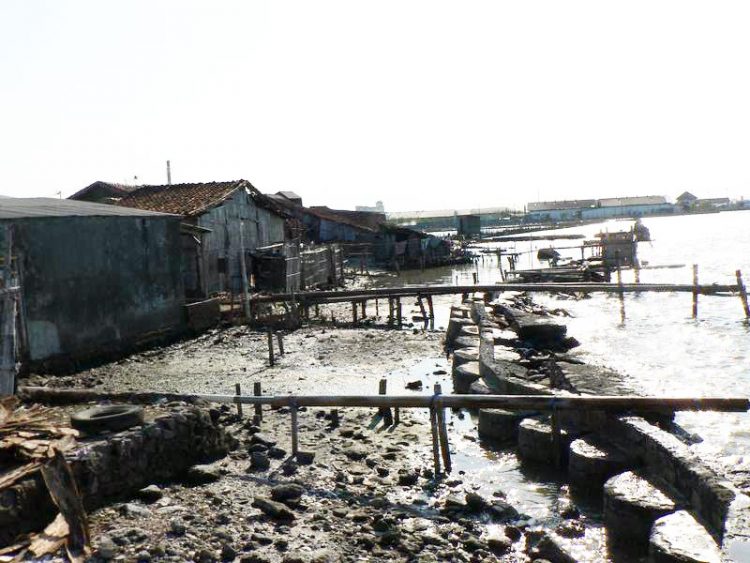Small- and mid-sized cities particularly vulnerable

In the city of Semarang / Indonesia residents are fighting against rising sea levels and frequent flooding. Jörn Birkmann
Small and mid-size not mega cities are growing quickest and are highly vulnerable to extreme events and climate change – says a new study and paper in NATURE developed by an international team of researchers coordinated by Prof. Joern Birkmann (University of Stuttgart).
In the upcoming UN Conference on Cities (UN-Habitat III, 17-20 October 2016) rapidly growing small- and mid-sized cities in Africa and Asia that are highly susceptible to natural hazards need more attention, since these cities will decide about the success or failure of the New Urban Agenda.
At Habitat III around 170 countries will adopt the United Nations’ New Urban Agenda calling for governments to make cities more inclusive, sustainable and resilient. Small and medium-sized cities are particularly susceptible to natural hazards and climate change and often have limited capacities to build resilience.
Research and political attention in the past has often been given to the growth of mega-cities, but it will be the fast-growing small (populations of 0.3-0.5 million) and medium-sized (0.5 to 5 million) cities, especially in Africa and Asia where the success or failure of sustainable urban development will be decided.
Cities like Kampala in Uganda, Niamey in Niger and Chittagong in Bangladesh face a host of pressures that make them especially vulnerable to natural hazards. They are experiencing high relative rates of population growth while combating poverty, poor infrastructure and governance.
It is fitting that the UN Habitat III conference will be held from 17th to 20th October in Quito, Ecuador. In April, the city and nearby Portoviejo and Manta suffered an earthquake that killed more than 660 people and injured at least 10,000. Some 73,000 people were displaced to shelters, camps or host homes.
Over 700,000 people needed emergency assistance, such as safe drinking water, improved sanitation and hygiene kits. Three months on 11,000 people still lack basic services. Such devastation highlights how susceptible many cities are to natural hazards, from river and coastal flooding to drought, heat, storms, earthquakes, tsunamis and landslides.
Prof. Birkmann says: “In order to minimize human suffering, cities need to be able to anticipate, absorb, recover and learn quickly from adverse events. This requires clear priorities towards the most vulnerable and rapidly growing small- and medium-sized growing cities.“
The populations of medium and small cities around the world will rise by more than 32% (469 million people) between 2015 and 2030, compared with about 26% (203 million people) in large and megacities.
Despite these challenges and problems, strengthening the resilience of small and mid-sized cities offers opportunities. Smaller cities are easier to manage than megacities. Risk reduction and climate change strategies embedded now can expand as cities grow. And the coordination of and dialogues between different groups are more feasible in small cities.
To assess which countries have the highest urban vulnerability to natural hazards Prof. Joern Birkmann and Dr. Torsten Welle from the University of Stuttgart analysed the urban populations of 140 countries, including more than 1600 cities above 300,000 inhabitants. Based on a standard methodology (Welle et al. 2015), UN and World Bank data was used on urban populations, infrastructure and socio-economic indicators. In the absence of local data we used representative national data on insurance coverage, medical services and governance conditions.
The new study and comment in NATURE highlights the 15 countries where the most vulnerable urban population lives are: Afghanistan, Yemen, Haiti, Central African Republic, Niger, Nigeria, Cote d'Ivoire, Mauritania, Liberia, Pakistan, Mali, Iraq, Benin, Togo and Gambia.
Original publication:
Birkmann, Joern; Welle, Torsten, Solecki, William; Lawsa, Shuaib and Garschagen, Matthias (2016): Boost resilience of small and mid-sized cities, smaller settlements are growing faster than megacities — and they need more protection from extreme events, in: NATURE (vol. 537), pages 605-608
The Nature article and the supplement can be downloaded in online versions: http://nature.com/articles/doi:10.1038/537605a
More information:
Prof. Joern Birkmann, University of Stuttgart, Institute of Spatial and Regional Planning, Tel. ++ 49 (0)711 685-66333,
E-Mail joern.birkmann (at) ireus.uni-stuttgart.de
Media Contact
All latest news from the category: Earth Sciences
Earth Sciences (also referred to as Geosciences), which deals with basic issues surrounding our planet, plays a vital role in the area of energy and raw materials supply.
Earth Sciences comprises subjects such as geology, geography, geological informatics, paleontology, mineralogy, petrography, crystallography, geophysics, geodesy, glaciology, cartography, photogrammetry, meteorology and seismology, early-warning systems, earthquake research and polar research.
Newest articles

Uranium-immobilizing bacteria in clay rock
Microbial reduction reduces mobility of uranium compounds. When designing repositories for high-level radioactive waste in deep geological layers, various factors must be carefully considered to ensure their long-term safety. Among…

6G mobile communications tested in the Alps
Researchers at the University of Stuttgart achieve strongest connection. Making emergency calls even in remote areas and transmitting large amounts of data in real time? This is possible with the…

Optimising inventory management
Crateflow enables accurate AI-based demand forecasts. A key challenge for companies is to control overstock and understock while developing a supply chain that is resilient to disruptions. To address this,…




















